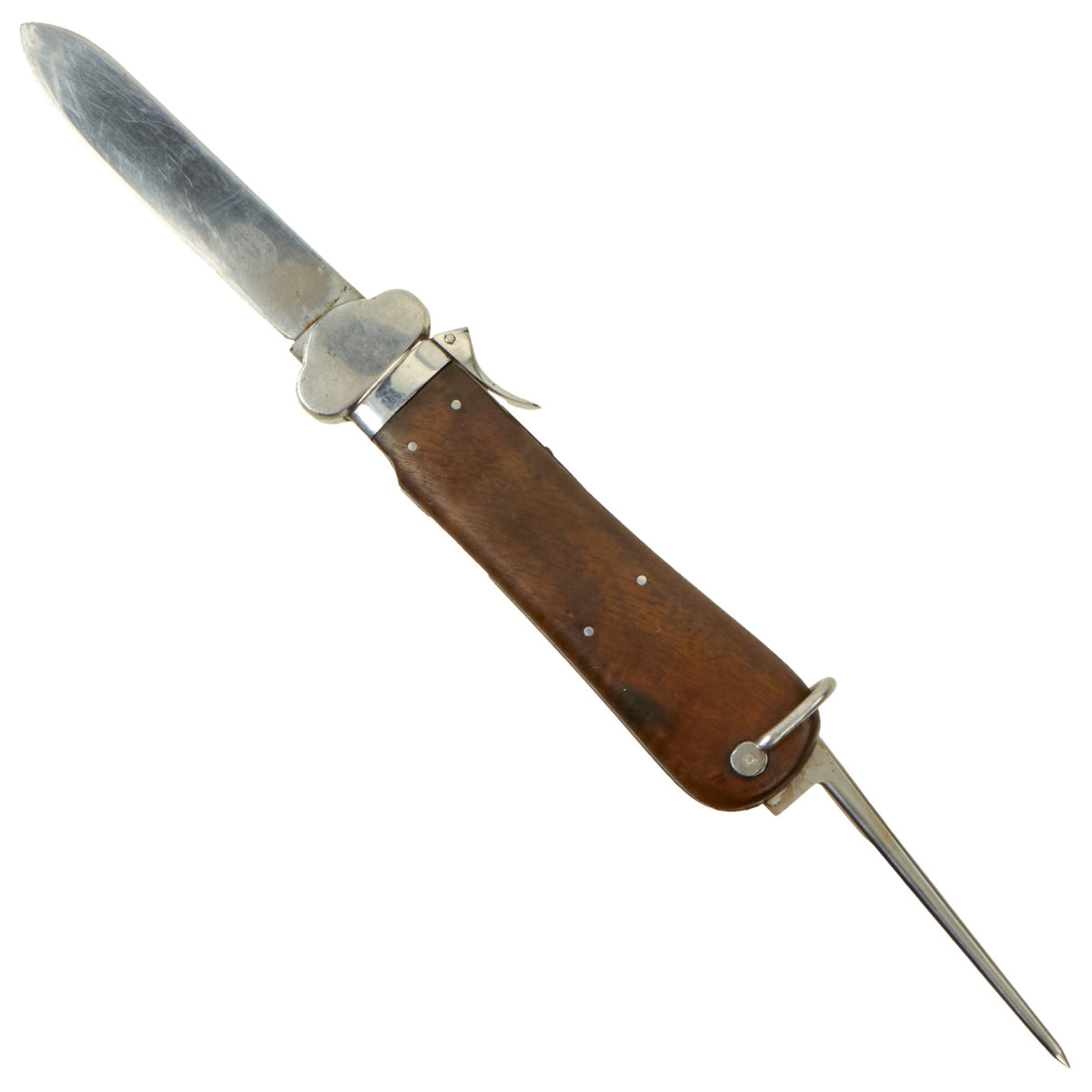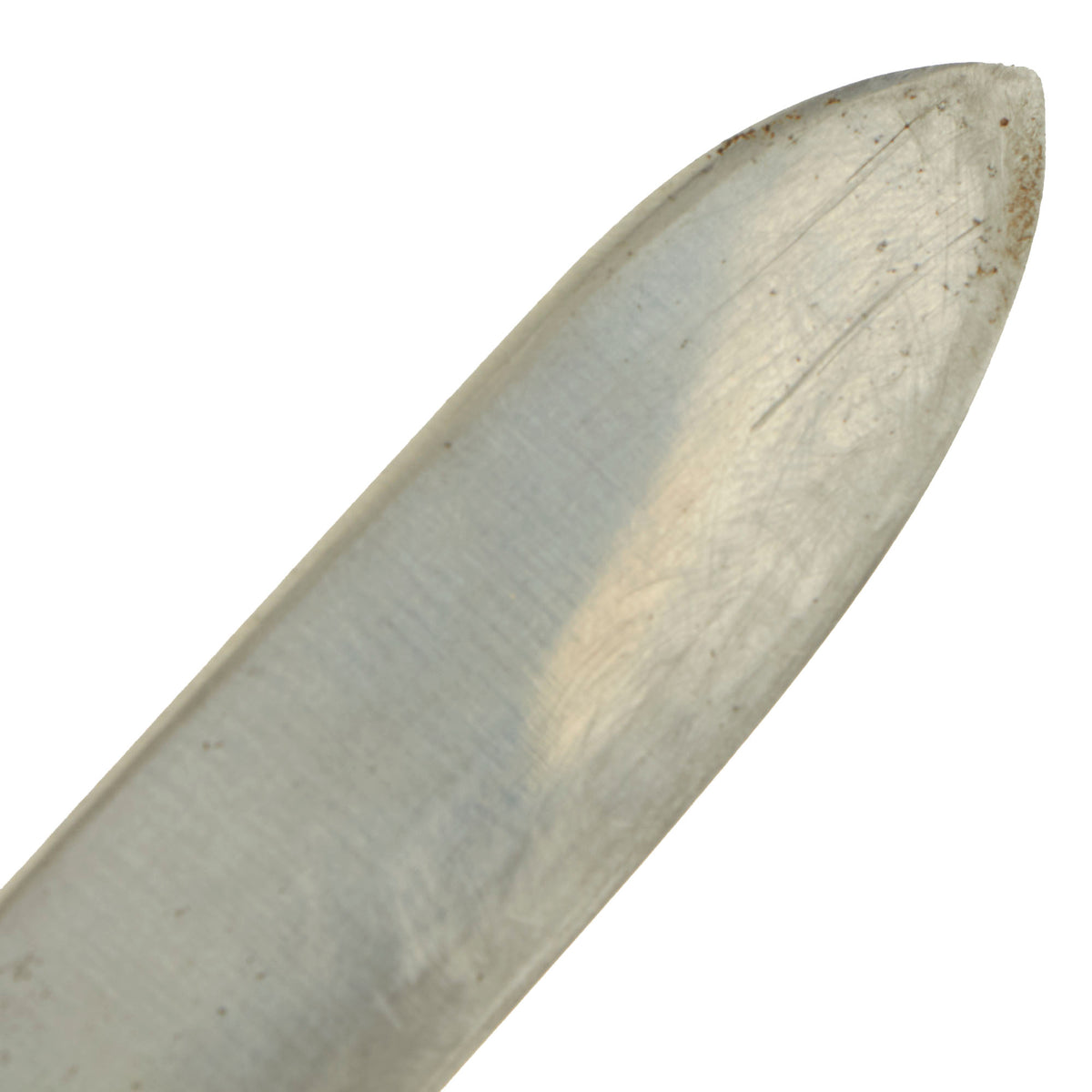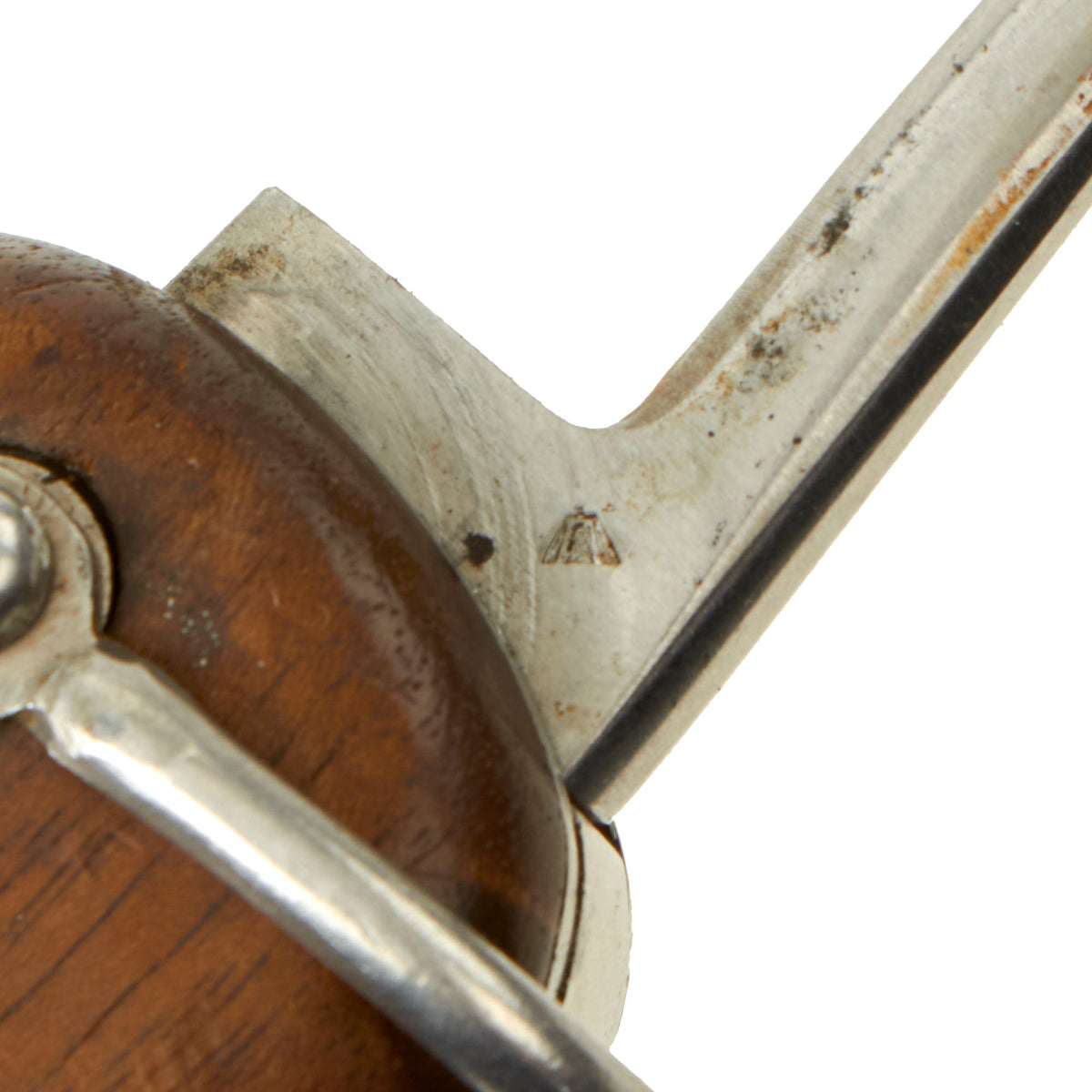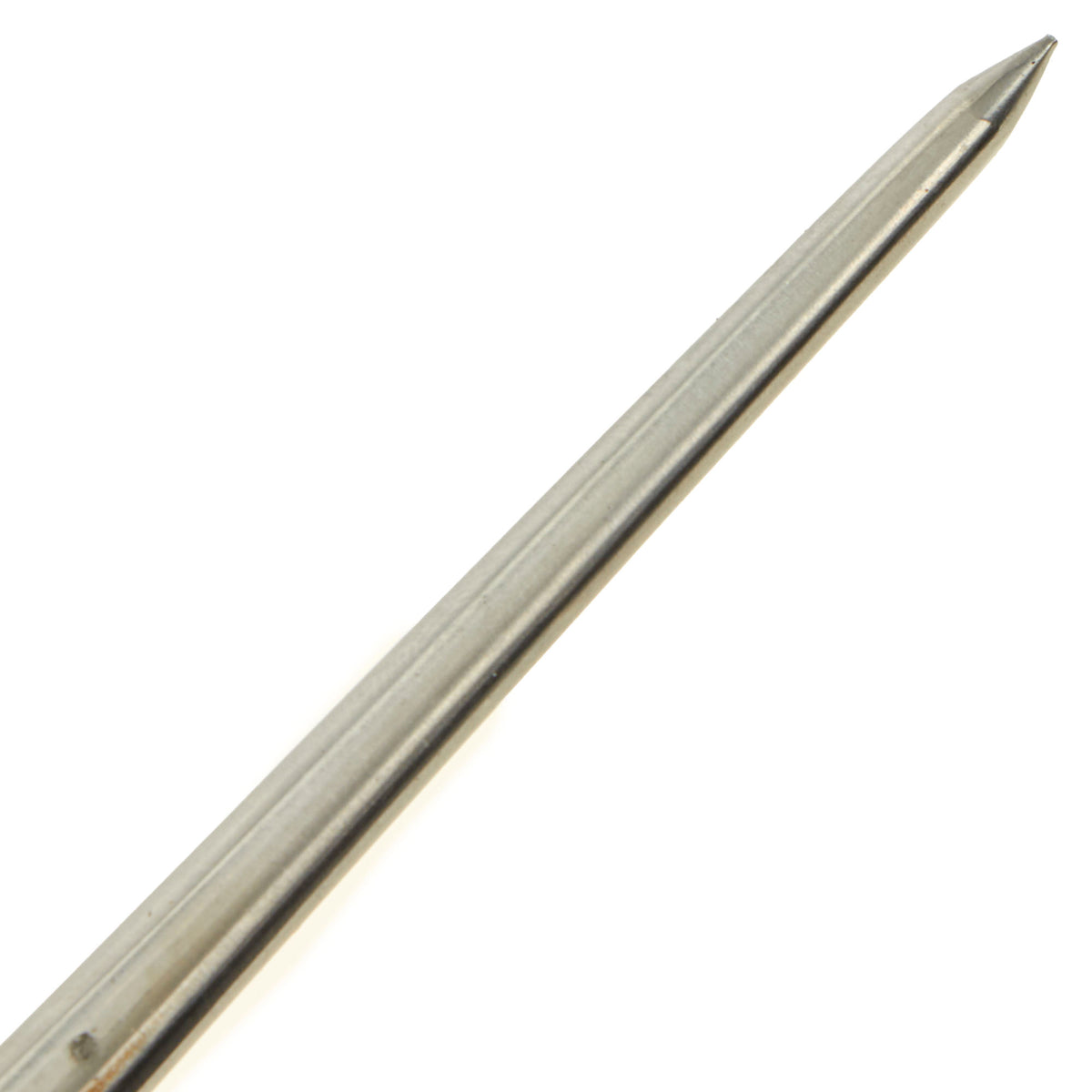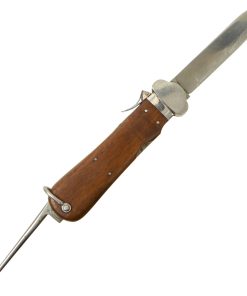Original German WWII Early Luftwaffe Gravity Knife by Paul Weyersberg & Co. of Solingen with Waffen Proof Original Items
$ 995,00 $ 248,75
Original Item: Only One Available. This is a very good example of an early-war produced Type I version of the legendary Luftwaffe Fallschirmjäger-Messer, or German air force paratrooper knife (FJM or FKm). It was produced by Paul Weyersberg & Co. of Solingen, who were one of the major producers of this knife during WWII. The company “Sword-and-Wreath” logo is etched into the blade, as well as ROSTFREI (rust free) indicating stainless steel construction. Solingen is known as the “City of Blades” and has a centuries-old history of edged weapon production.
These knives utilize a four-inch (100 mm) telescoping (OTF), gravity-propelled locking blade. First produced in 1937, the FJM was issued to German flight crews and paratroops, primarily for the purpose of cutting a trapped parachutist from his rigging in case he landed with a tangled parachute, or became entangled in trees with the shroud lines. Though not intended for use as a fighting knife, the FJM’s blade could be and was used as a close combat weapon when necessary.
The Luftwaffe Fallschirmjäger-Messer uses a sliding blade inside a metal grip frame, which was originally fitted with smooth wood scales, usually of beech or walnut. The blade itself is a relatively blunt spear-point, and the profile is flat ground, tapering to a utility edge. To open the blade, the user points the FJM downwards while flipping up the fulcrum-style operating lever, allowing gravity to draw out the blade to its fullest extent. Releasing the lever locks the blade into position. The FJM may also be opened by flipping the blade release lever while flicking the wrist holding the knife, causing the blade to extend. The FJM was also equipped with a folding marlinspike or awl. Primarily intended for untangling rope knots, it can also be used as a prying tool. The FJM’s spike does not lock when opened and was never intended to be used as a combat weapon, though individual German paratroopers may have employed it as such.
There are three principal types of wartime-era Luftwaffe Fallschirmjäger-Messers. The Type I FKm has wood scales (handle), was made from 1937-1941, and unlike successive models, has no ‘takedown’ capability. The Type II FKm is the same knife, but with takedown features, and was produced from 1941 to the end of World War II.
This example of a Type I FJM has fine, stainless steel components. There is a number 5 inside a Waffen Eagle on the base of the marlin spike. This is the standard Luftwaffe inspection stamp style used throughout the war. It also is marked with assembly number 104 on both the lever and base of the blade release, indicating that it has not been replaced. The knife is fully functional, with all parts intact and no springs broken. The blade release functions properly, the blade extends and locks into place, and the marlin spike swings out and locks into place as well.
The blade of this knife is in very good condition, showing signs of light use, with some scuffing from use and cleaning. It has definitely been sharpened, and the tip has been a bit changed in shape due to this. It still displays much of the original factory final polish grind crossgrain, an identifying feature of a true German WWII blade. The edge of the blade is still relatively sharp.
The grip plates are of walnut with the standard four retaining rivets, and are in very good condition, showing only a few noticeable nicks and scuffs with minor wear. The grain is great, and this is definitely one of the better grips we have seen recently.
A very good condition Luftwaffe Gravity Knife from the famed “City of Blades”! Ready to display!
Specifications:
Blade Length: 4″
Blade Style: Single Edge Knife
Overall length: 10 1/8”
Crossguard: 1 7/16”
Flieger-Kappmesser / Luftwaffe Gravity Knife (LGK)
One of the most recognizable gravity knives is the World War II-era Flieger-Kappmesser (literally: “flyers-cutting knife”), which utilizes a four-inch (100 mm) telescoping (OTF), gravity-propelled locking blade. First produced in 1937, the often so called Fallschirmjägermesser was initially issued to German flight crews and paratroops, primarily for the purpose of cutting a trapped parachutist from his rigging in case he landed with a tangled parachute, or became entangled in trees or in the water with the shroud lines. The spike was used to untie knots while packing the parachutes. Luftwaffe air crew members used the knife to cut themselves out of their harnesses or cut through the aluminum hull of the aircraft after a crash landing. Though not intended for use as a fighting knife in the first place, the LGK was introduced to the 1st Skijäger Division and SS units on the Eastern Front to be used primarily as a close combat weapon from 1944 on.
The Flieger-Kappmesser uses a sliding blade inside a metal gripframe, which was originally fitted with smooth wood scales. The blade itself is a relatively blunt spear-point, and the profile is flat ground, tapering to a utility edge. To open the blade, the user points the knife downwards while flipping up the fulcrum-style operating lever, allowing gravity to draw out the blade to its fullest extent. Releasing the lever locks the blade into position. The LGK may also be opened by flipping the blade release lever while flicking the wrist holding the knife, causing the blade to extend. The LGK was also equipped with a folding marlinspike or awl. Primarily intended for untangling rope knots, it was also used as a prying tool or to fix jammed weapons. The spike does not lock when opened and was never intended to be used as a combat weapon.
There are two principal types of wartime-era Flieger-Kappmesser with altogether 10 known variations. The Type I LGK (three manufacturers, five WWII variations) has wood scales (handle), was made from 1937-1943, and unlike successive models, has no ‘takedown’ capability. The Type II LGK (two manufacturers, five WWII variations) is the same knife, but with takedown features, and was produced from 1943 until 1945 and then again from ca. 1950 until 1965.
After the end of World War II, the newly organized West German Bundeswehr placed new orders with German cutlery manufacturers for a postwar version of the Kappmesser for issue to the Army’s airborne forces and tank crews. The West German Luftwaffe abandoned the gravity knife concept completely and purchased completely different rescue knives including a shroud line cutter. The initial Type III “trap door” gravity knife, made from 1955-1961 did not prove to be very reliable and thus, the original WWII Type II design was reintroduced until it was finally replaced by the early Type IV knives in appr. 1968. The Type IV LGK, is very similar to the WWII-production Type II takedown knife, but features plastic polymer instead of wooden scales and was made by WMF, OFW and Eickhorn from 1972-1984. They were issued to the Bundeswehr soldiers until 2017. The third West German post-war model is the Type V LGK, initially named AES79 and still today produced under the designation LL80 (1979–present) by Eickhorn. The LL80 is smaller, has fewer parts and is more cost-effective to produce than the earlier Flieger-Kappmesser. It was procured by the Swiss Air Force and issued to their Dassault Mirage pilots in 1983. These knives are marked AES83 and bear the number of the aircraft of the metal head.
On the other side of the Iron Curtain, in the German Democratic Republic, WWII Gravity Knives were refurbished and re-issued to the paratroopers and pilots until the existing stock was gone. In the early 1960s two companies then produced an East German Version of the Type I knives. They were then used until the early 1970s.
Fast Shipping with Professional Packaging
Thanks to our longstanding association with UPS FedEx DHL, and other major international carriers, we are able to provide a range of shipping options. Our warehouse staff is expertly trained and will wrap your products according to our exact and precise specifications. Prior to shipping, your goods will be thoroughly examined and securely secured. We ship to thousands clients each day across multiple countries. This shows how we're dedicated to be the largest retailer on the internet. Warehouses and distribution centres can be located throughout Europe as well as the USA.
Note: Orders with more than one item will be assigned a processing date depending on the item.
Before shipping before shipping, we'll conduct a thorough inspection of the items you have ordered. Today, the majority of orders will be delivered within 48 hours. The delivery time will be between 3-7 days.
Returns
The stock is dynamic and we cannot completely manage it because multiple stakeholders are involved, including our factory and warehouse. So the actual stock may alter at any time. It's possible that you may not receive your order once the order has been made.
Our policy is valid for a period of 30 days. If you don't receive the product within 30 days, we are not able to issue a refund or an exchange.
You can only return an item if it is unused and in the same state as the day you received it. You must have the item in its original packaging.
Related products
Uncategorized
Armored Burgonet Helmet & Polearm from Scottish Castle Leith Hall Circa 1700 Original Items
Uncategorized
Uncategorized
Uncategorized
Uncategorized
Uncategorized
Uncategorized
Uncategorized
Australian WWII Owen MK1 Machine Carbine SMG Custom Fabricated Replica with Sling Original Items
Uncategorized
Uncategorized
Uncategorized
Uncategorized
Uncategorized
Uncategorized
Armoured Fighting Vehicles of the World: AFVs of World War One (Hardcover Book) New Made Items
Uncategorized

